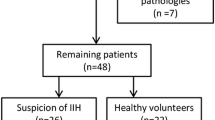Abstract
Idiopathic intracranial hypertension (IIH) is a disorder of raised intracranial pressure (ICP) in the absence of identifiable pathology. The purpose of this study was to evaluate the clinical presentation and monitor a 3-month course using frequent optical coherence tomography (OCT) evaluations, visual field testings and lumbar opening pressure measurements. A longitudinal study of 17 patients with newly diagnosed IIH and 20 healthy overweight controls were included in the study. Peripapillary retinal nerve fiber layer thickness (RNFLT) and retinal thickness (RT) measurements (Stratus OCT-3, fast RNFL 3.4 protocol), and Humphrey visual field testing were evaluated at regular intervals. Repeat lumbar puncture was performed at final visit (n = 13). The diagnostic delay was 3 months and initial symptoms were headache (94%), visual blurring (82%) and pulsatile tinnitus (65%). Complete clinical remission was achieved in 65%, partial in 29% and unchanged symptoms in 6%. Total average RNFLT and RT decreased significantly during the follow-up period (p < 0.0001 and p < 0.0001, respectively). Changes in RNFLT and RT correlated with improvements in visual field mean deviation (MD) (RNFLT: p = 0.006; RT: p = 0.03) and pattern standard deviation (PSD) (RNFLT: p = 0.002; RT: p = 0.003). In patients with weight-loss >3.5% of BMI, ICP decreased significantly (p = 0.0003). In patients with weight-loss <3.5% of BMI, changes in ICP were insignificant (p = 0.6). OCT combined with visual field testing may be a valuable objective tool to monitor IIH patients and the short term IIH outcome is positive. Weight-loss is the main predictor of a favorable outcome with respect to CSF pressure.



Similar content being viewed by others
References
Headache Classification Subcommittee of the International Headache Society (2004) The international classification of headache disorders, 2nd edn. Cephalalgia 24(Suppl 1): 9–160
Friedman DI, Jacobson DM (2002) Diagnostic criteria for idiopathic intracranial hypertension. Neurology 59:1492–1495
Skau M, Brennum J, Gjerris F, Jensen R (2006) What is new about idiopathic intracranial hypertension? An updated review of mechanism and treatment. Cephalalgia 26:384–399
Sugerman HJ, Felton WL, Salvant JB, Sismanis A, Kellum JM (1995) Effects of surgically induced weight loss on idiopathic intracranial hypertension in morbid obesity. Neurology 45:1655–1659
Sugerman HJ, Felton WL, Sismanis A, Kellum JM, DeMaria EJ, Sugerman EL (1999) Gastric surgery for pseudotumor cerebri associated with severe obesity. Ann Surg 229:634–640
Kupersmith MJ, Gamell L, Turbin R, Peck V, Spiegel P, Wall M (1998) Effects of weight loss on the course of idiopathic intracranial hypertension in women. Neurology 50:1094–1098
Wong R, Madill SA, Pandey P, Riordan-Eva P (2007) Idiopathic intracranial hypertension: the association between weight-loss and the requirement for systemic treatment. BMC Ophthalmol 7:15–20
Johnson LN, Krohel GB, Madsen RW, March GA (1998) The role of weight loss and acetazolamide in the treatment of idiopathic intracranial hypertension. Ophthalmology 105:2313–2317
Rowe FJ, Sarkies NJ (1999) The relationship between obesity and idiopathic intracranial hypertension. Int J Obes Relat Metab Disord 23:54–59
Michaelides EM, Sismanis A, Sugerman HJ, Felton WL (2000) Pulsatile tinnitus in patients with morbid obesity: the effectiveness of weight reduction surgery. Am J Otol 21:682–685
Rebolleda G, Munoz-Negrete FJ (2009) Follow-up of mild papilledema in idiopathic intracranial hypertension with optical coherence tomography. Invest Ophthalmol Vis Sci 50:5197–5200
Schuman JS, Hee MR, Puliafiro CA et al (1995) Quantification of nerve fiber layer thickness in normal and glaucomatous eyes using optical coherence tomography. Arch Ophthalmol 113:586–596
Pons ME, Garcia-Valenzuela E (2005) Redefining the limit of the outer retina in optical coherence tomography scans. Ophthalmology 112:1079–1085
Frisén L (1982) Swelling of the optic nerve head: a staging scheme. J Neurol Neurosurg Psychiatry 45:13–18
Parikh RS, Parikh SR, Sekhar GC, Prabakaran S, Babu JG, Thomas R et al (2007) Normal age-related decay of retinal nerve fiber layer thickness. Ophthalmology 114:921–926
Budenz DL, Anderson DR, Varma R et al (2007) Determinants of normal retinal nerve fiber layer thickness measured by stratus OCT. Ophthalmology 114:1046–1052
Thambisetty M, Lavin PJ, Newman NJ, Biousse V (2007) Fulminant idiopathic intracranial hypertension. Neurology 68:229–232
Salgarello T, Falsini B, Tedesco S, Galan ME, Colotto A, Scullica L (2001) Correlation of optic nerve head tomography with visual field sensitivity in papilledema. Invest Ophthalmol Vis Sci 42:1487–1494
Karam EZ, Hedges TR (2005) Optical coherence tomography of the retinal nerve fiber layer in mild papilloedema and pseudopapilloedema. Br J Ophthalmol 89:294–298
El-Dairi MA, Holgado S, O’Donnell T, Buckley EG, Asrani S, Freedman SF (2007) Optical coherence tomography as a tool for monitoring pediatric pseudotumor cerebri. J AAPOS 11:564–570
Wall M, George D (1991) Idiopathic intracranial hypertension. A prospective study of 50 patients. Brain 114:155–180
Rowe FJ, Sarkies NJ (1998) Assessment of visual function in idiopathic intracranial hypertension: a prospective study. Eye 12:111–118
Capris P, Autuori S, Capris E, Papadia M (2008) Evaluation of threshold estimation and learning effect of two perimetric strategies, SITA Fast and CLIP, in damaged visual fields. Eur J Ophthalmol 18:182–190
Durcan FJ, Corbett JJ, Wall M (1988) The incidence of pseudotumor cerebri. Population studies in Iowa and Louisiana. Arch Neurol 45:875–877
Acknowledgments
This study was sponsored by Research Foundation of Capital Region, VELUX foundation and the John and Birthe Meyer Foundation. The authors report no disclosures or conflicts of interest.
Author information
Authors and Affiliations
Corresponding author
Rights and permissions
About this article
Cite this article
Skau, M., Sander, B., Milea, D. et al. Disease activity in idiopathic intracranial hypertension: a 3-month follow-up study. J Neurol 258, 277–283 (2011). https://doi.org/10.1007/s00415-010-5750-x
Received:
Accepted:
Published:
Issue Date:
DOI: https://doi.org/10.1007/s00415-010-5750-x




